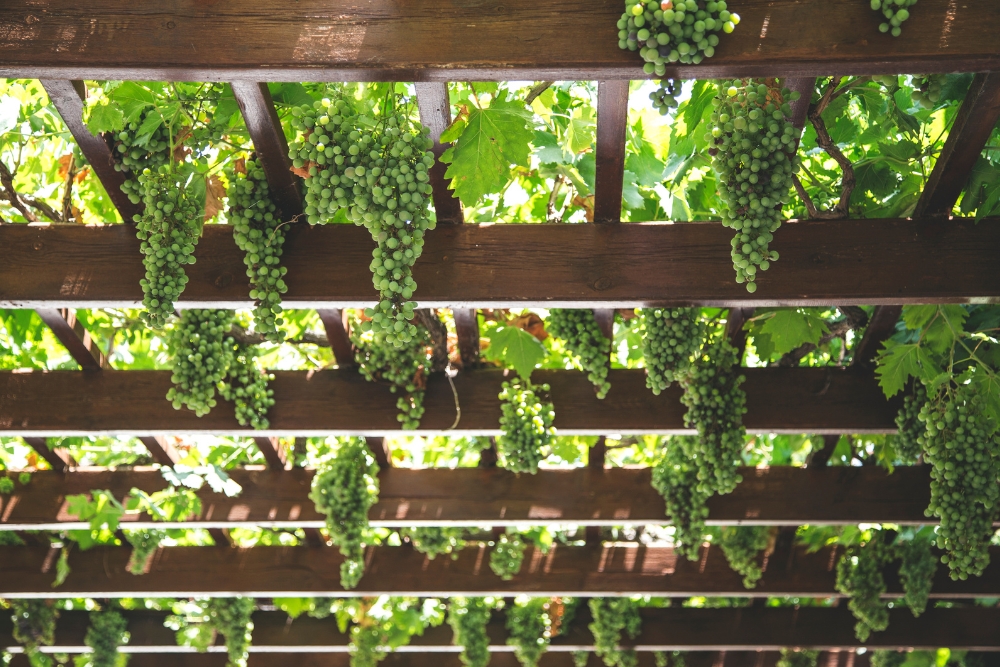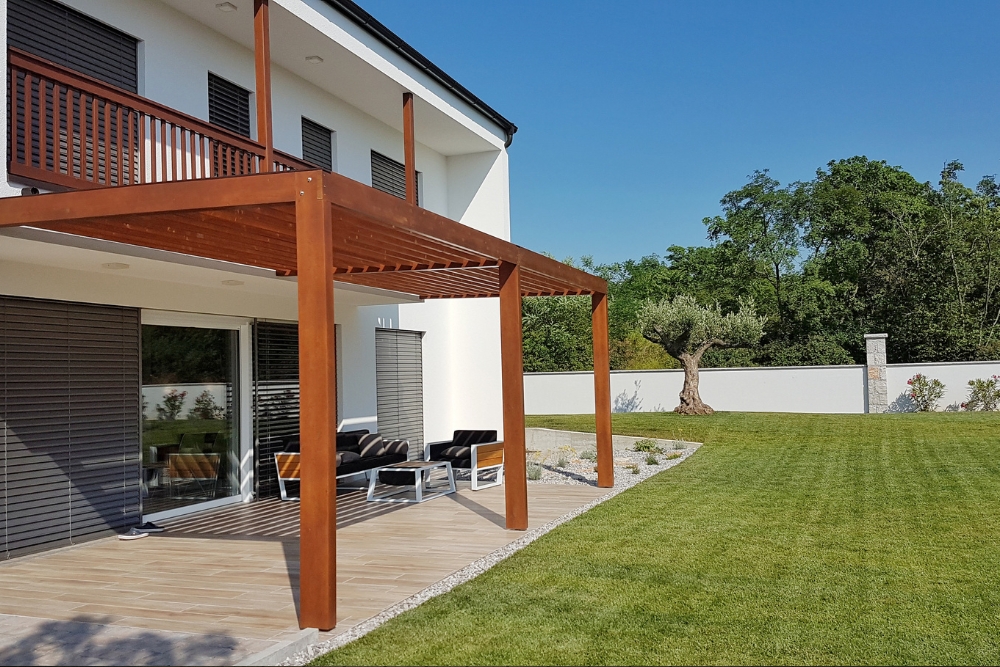Ever pondered about how to swap your garden from drab to brilliantly fab? We’ve travelled that path mates and uncovered that wooden pergolas swathed in lively, climbing vines can genuinely transform the space! This blog post is going to guide you through it all – sussing out what a pergola actually is, how it can spruce up your space, picking appropriate vine species and even really unpacking the cost difference between buying versus building.
Key Takeaways
- A wooden pergola enhances outdoor spaces by adding both shade and privacy to gardens.
- Climbing plants like honeysuckle and clematis can be incorporated into pergola designs to create a lush green oasis.
- Adding a pergola as a walkway feature or combining it with trellises or arbours can create stunning garden pathways.
- When considering buying or building a wooden pergola, it’s important to compare costs and decide whether DIY or hiring a professional is the best option.
What is a Pergola?
A pergola is a wooden outdoor structure that serves both functional and aesthetic purposes in the garden. It can be attached to the house or freestanding, providing a shaded walkway or seating area adorned with climbing vines such as honeysuckle or clematis.
Definition and purpose
A pergola serves as a distinct and inviting structure in your backyard or garden space. It’s defined by vertical posts or pillars supporting cross beams with an open grid, creating an airy shelter perfect for relaxation and entertainment.
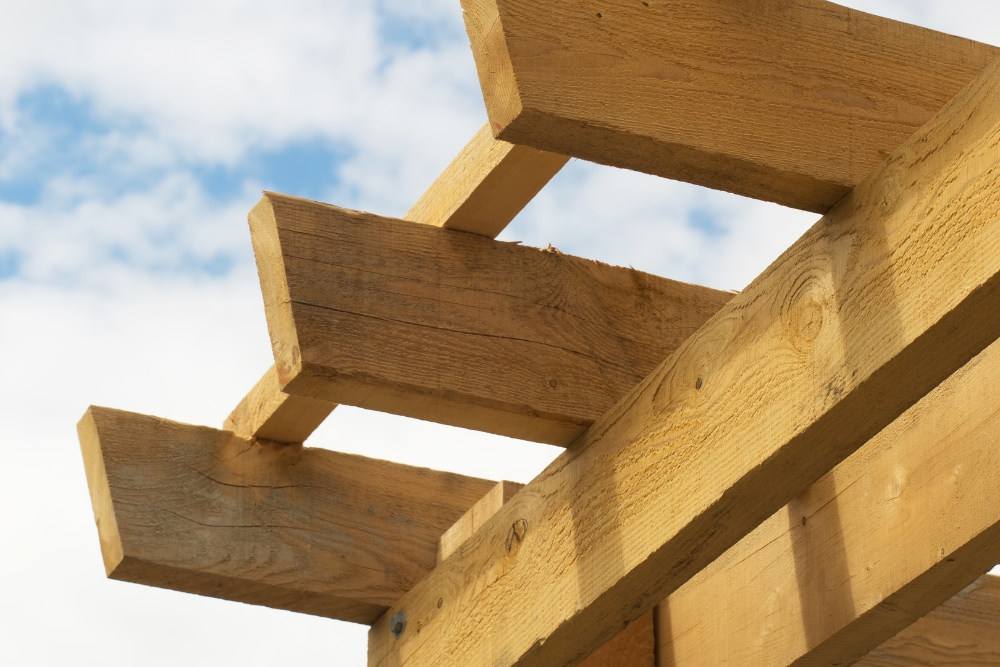
This unique outdoor feature can cover pathways, provide shade over seating areas, create a stylish transition from indoors to out or simply add visual interest to your garden. The purpose of pergolas extends beyond aesthetics; they also provide functional benefits such as shade and privacy when covered with lush climbing vines.
These natural canopies transform your wooden pergola into a green oasis, offering you a cool refuge on hot summer days while infusing charm into vine-covered garden pathways. Whether left open or wrapped with beautiful climbers, pergolas unite function and beauty to enhance the appeal of any outdoor space.
Types of pergolas (attached, freestanding)
We offer two main types of pergolas: attached and freestanding. An attached pergola is connected to the side of a building, such as your house or garage. It provides an extension of your outdoor living space and can be used to create a covered patio area.
On the other hand, a freestanding pergola stands on its own and can be placed anywhere in your garden or yard. This type of pergola is perfect for creating a separate sitting area or walkway in your outdoor space.
Whether you choose an attached or freestanding pergola, both options provide a beautiful addition to your home and enhance your outdoor ambience with their elegant design and functionality.
Benefits of a Wooden Pergola
A wooden pergola enhances our outdoor space, adding both shade and privacy to our garden.
Enhances outdoor space
Wooden pergolas are a fantastic addition to any outdoor space as they enhance its overall appeal. These elegant and minimalistic structures provide a beautiful focal point and create an inviting atmosphere for relaxation and entertaining.
With their open-topped canopies, wooden pergolas offer the perfect balance of shade and sunlight, making them ideal for covering seating areas, pool zones, gardens, or pathways. By incorporating climbing plants like fast-growing vines, you can transform your pergola into a lush green oasis that adds natural beauty to your outdoor space.
Whether you have a small patio or a spacious backyard, adding a wooden pergola will undoubtedly elevate the charm and ambience of your surroundings.
Adds shade and privacy
Wooden pergolas enhance your outdoor space by adding both shade and privacy. The sturdy roofing grid provides ample coverage, creating a shaded area where you can relax or entertain guests.
With the option to cover the pergola with climbing vines, you can further increase the shade and privacy provided. These vine-covered pergolas create a natural barrier, shielding you from prying eyes while adding a touch of greenery to your garden pathway.
Enjoy the perfect balance of sunlight and seclusion with a wooden pergola that adds both shade and privacy to your outdoor living space.
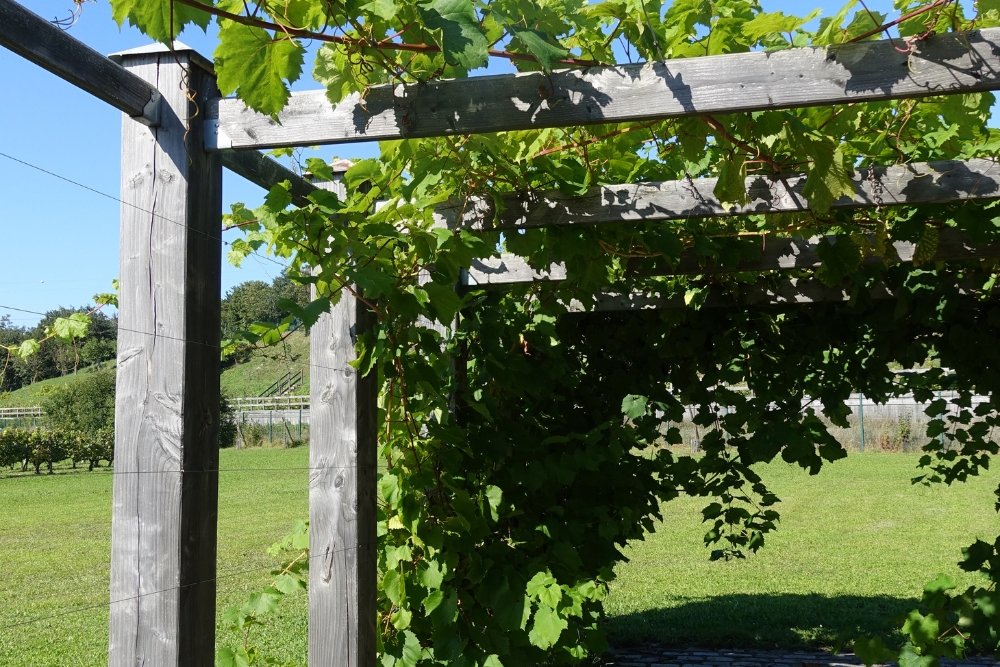
How to Incorporate Vines into Pergola Design
To incorporate vines into your pergola design, choose the right climbing plants such as honeysuckle and clematis that thrive in Australian gardens. Properly plant and maintain the vines to ensure they grow healthily.
Train them on the pergola structure with some helpful tips.
Choosing the right climbing plants (honeysuckle, clematis, etc.)
We can enhance the beauty of our wooden pergolas by choosing the right climbing plants. Honeysuckle and clematis are excellent choices for adding a touch of natural elegance to your garden pathways.
These fast-growing climbers will quickly cover your pergola, creating a lush green canopy that provides shade and privacy. With their vibrant flowers and fragrant scent, these plants will transform your outdoor space into a picturesque oasis.
Plus, they are easy to maintain and require minimal effort to train them on the pergola structure. So why not bring nature closer to your home with these beautiful climbing plants?
Proper planting and maintenance
To ensure the success of your vine-covered pergola, proper planting and maintenance are crucial. When choosing climbing plants for your pergola, opt for fast-growing varieties like honeysuckle or clematis that can quickly cover the structure.
Plant them at the base of each vertical post, providing enough space for their roots to grow. Regular watering is essential during the initial stages to help establish strong root systems.
As the vines begin to grow, train them along the crossbeams and laterals of the pergola using twine or clips. Pruning is necessary to maintain a neat appearance and promote healthy growth.
Tips for training vines on pergola structures
We have some helpful tips for training vines on your pergola structures. First, choose the right climbing plants such as honeysuckle or clematis that are well-suited for pergolas. When planting them, make sure to provide proper support and regular maintenance to encourage growth along the structure.
Additionally, prune the vines regularly to maintain their shape and prevent overgrowth. Remember to guide the vines along the crossbeams of your pergola to create a beautiful green canopy effect.
With these tips, you can easily transform your pergola into a lush and inviting space in your garden pathway.
Creative Pergola Ideas for Garden Pathways
To create a stunning garden pathway, consider adding a pergola as a walkway feature and combining it with climbing vines for a green tunnel effect.
Adding a pergola as a walkway feature
We love the idea of adding a pergola as a walkway feature in your garden! A pergola not only creates a charming and picturesque pathway but also provides shade and adds an elegant touch to your outdoor space.
With its vertical posts and crossbeams, a wooden pergola offers the perfect structure for climbing vines, creating a lush green tunnel effect. By incorporating fast-growing climbers such as honeysuckle or clematis, you can transform your walkway into a beautiful natural canopy.
Whether you’re looking to enhance your garden’s ambience or create an inviting entrance, a pergola walkway is sure to impress.
Creating a green tunnel with a pergola and vines
We can turn your garden pathway into a stunning and lush green tunnel by incorporating a pergola covered in climbing vines. The wooden pergola not only adds structure and elegance to your outdoor space but also provides a shaded walkway for you to enjoy.
By carefully choosing fast-growing climbers like honeysuckle or clematis, you can create a natural canopy of foliage that will transform your garden into a picturesque retreat. Proper planting and maintenance of the vines are essential to ensure healthy growth and coverage over the pergola structure.
Let us help you create a captivating and inviting atmosphere with our beautiful pergola designs adorned with vibrant greenery.
Combining with a trellis or arbor
We can take our wooden pergolas to the next level by combining them with a trellis or arbour. This creates a stunning visual effect and adds even more charm to your garden pathways.
By incorporating a trellis or arbour into the design, you can create a lush and vibrant walkway covered in climbing plants. The combination of the pergola’s vertical posts and pillars with the trellis or arbour’s lattice framework allows for an abundance of greenery to grow and intertwine, creating a truly picturesque pathway.
It’s an easy way to enhance your outdoor space while adding depth and character to your garden design.
Buying or Building a Pergola
When it comes to buying or building a pergola, there are several factors you need to consider. From the cost comparison to deciding whether you want to DIY or hire a professional, we have all the information you need to make an informed decision.
So, don’t miss out on this crucial step in creating your dream outdoor space.
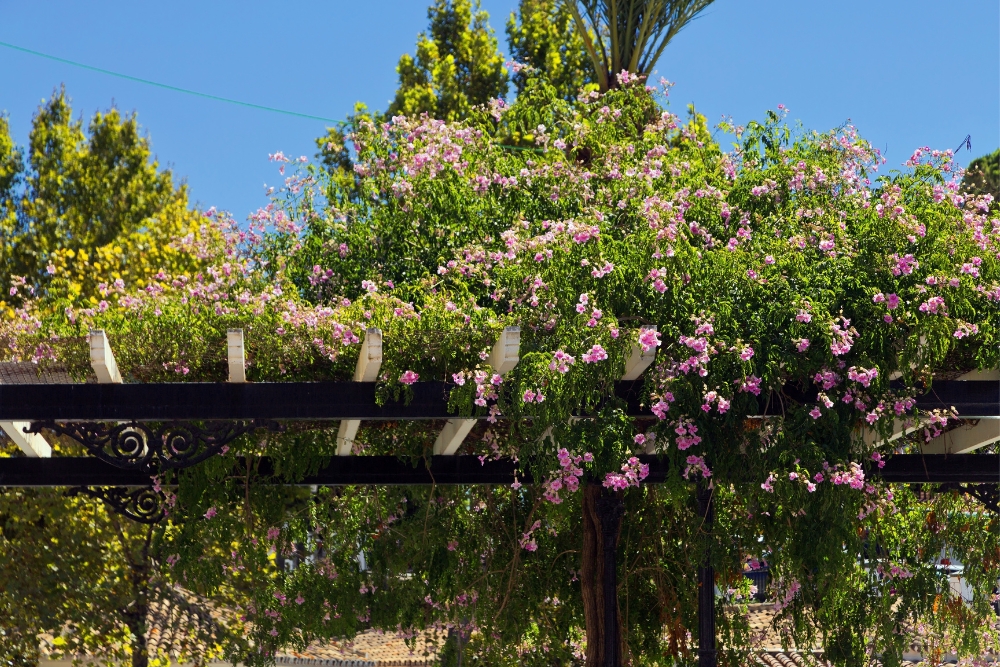
Cost Comparison
When considering buying or building a wooden pergola for your garden pathway, it’s important to compare the costs. DIY pergola kits are generally more affordable than hiring a professional to build one for you.
However, keep in mind that building a pergola yourself will require time, effort, and some basic carpentry skills. On the other hand, hiring a professional may be a bit pricier but can save you the hassle of construction and ensure high-quality craftsmanship.
Additionally, consider the long-term expenses of maintenance and vine care if you choose to cover your pergola with climbing plants. By comparing the costs and weighing your options, you can make an informed decision that suits your budget and meets your desired outcome.
DIY vs. hiring a professional
When it comes to buying or building a wooden pergola for your vine-covered garden pathway, you have two options: DIY or hiring a professional. There are several factors to consider before making this decision.
Firstly, cost is an important consideration. DIY pergolas can be more affordable since you won’t need to pay for labour costs. However, if you don’t have the necessary skills and tools, mistakes could end up costing more in the long run.
Hiring a professional ensures expertise and a well-built pergola, but it may come with a higher price tag. Secondly, time and effort should be taken into account. Building a pergola yourself requires planning, sourcing materials, and dedicating time to construction.
Important factors to consider
When considering a wooden pergola for your vine-covered garden pathway, there are a few important factors to keep in mind. Firstly, think about the size and location of the pergola.
Measure your space carefully to ensure that the pergola will fit comfortably without overwhelming the area. Consider where you want to place it in your garden to maximise its impact and create an inviting pathway.
Next, think about the materials used in constructing the pergola. Wooden pergolas are popular due to their natural beauty, but make sure that they are treated or built with rot-resistant wood for longevity.
Additionally, consider how much maintenance is required for the specific type of wood chosen.
Lastly, before purchasing or building a wooden pergola, think about any necessary permissions or regulations from local authorities. It’s important to check if you need planning permission or if there are any restrictions on height or design in your area.
Your Space, Our Aluminium Pergola Craftsmanship
Wooden pergolas are a popular and elegant choice for enhancing outdoor spaces such as gardens and pathways. They provide shade, and privacy, and can be transformed into lush green tunnels with the addition of climbing vines.
Whether you choose to build your own or hire a professional, incorporating a wooden pergola into your garden design will add charm and beauty to your outdoor living space. So why not create a picturesque pathway with a vine-covered pergola today?
Transform your garden into a whimsical wonderland with Wooden Pergolas for vine-covered pathways. Take action now to create enchanting outdoor spaces. Contact Aluminium Pergolas today to explore our exquisite range of Wooden Pergolas perfect for creating vine-covered garden pathways that lead to magic. Don’t let your garden pathways be ordinary – trust Aluminium Pergolas to be your partner in crafting pathways that are not only functional but also bursting with natural beauty. Don’t wait for lacklustre garden paths – reach out now and create the fairy tale setting you’ve always dreamed of with Wooden Pergolas. Act today for an enchanting and inviting garden. Contact us now!

